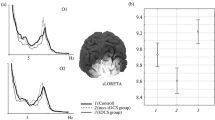Abstract
Analysis of the magnetic resonance imaging (MRI) data in children with mental disorders of perinatal origin showed that, in 70% of cases, pathological damage to the brain structures is absent, or only minimal residual changes are detected. At the same time, the EEG α-rhythm in the occipitoparietal areas was not regular in 77% of cases. The predominance of the signs of cerebral functional insufficiency allows efficacious use of the physiological methods of correction of mental disorders using transcranial direct current stimulation.
Similar content being viewed by others
References
Kropotov, Yu.D., Chutko, L.S., Grin’-Yatsenko, V.A., et al. Application of transcranial micropolarization in the treatment of the hyperactive attention disorder syndrome in children and adolescents, Zh. Nevrol. Psikhiatr. im. S.S. Korsakova, 2002, vol. 105, no. 5, p. 26.
Kozhushko, N.Yu., Ponomareva, E.A., Ilyukina, V.A., et al. Method of treatment of developmental mental disorders in children, RF Inventor’s Certificate no. 2248227, Byull. Izobret., 2005, no. 8.
Ilyukina, V.A., Matveev, Yu.K., and Chernysheva, E.M., Transkranial’naya mikropolyarizatsiya v fiziologii i klinike (Transcranial Micropolarization in Physiology and Clinical Setting), St. Petersburg, 2006.
Kozhushko, N.Yu., Shaitor, V.M., Ponomareva, E.A., and Berezhnaya, N.F., Experience of the use of transcranial micropolarizations in the complex therapy of early autism in children, Zh. Nevrol. Psikhiatr. im. S.S. Korsakova, 2007, vol. 107, no. 10, p. 47.
Pinchuk, D.Yu., Transkranial’nye mikropolyarizatsii golovnogo mozga (Transcranial Micropolarizations of the Brain), St. Petersburg: Chelovek, 2007.
Shelyakin, A.M., Preobrazhenskaya, I.G., and Bogdanov, O.V., Mikropolyarizatsionnaya terapiya v detskoi nevrologii (Micropolarization Therapy in Pediatric Neurology), Moscow: Medkniga, 2008.
Chutko, L.S., Livinskaya, A.M., Nikishena, I.S., et al. Transcranial micropolarization in the treatment of specific speech disorders in children, Ross. Pediatr. Zh., 2007, no. 5, p. 47.
Kozhushko, N.Yu. and Matveev, Yu.K., Method for correction of developmental mental disorders in children, RF Inventor’s Certificate no. 2402973, Byull. Izobret., 2010, no. 31.
Mikropolyarizatsii u detei s narusheniem psikhicheskogo razvitiya ili kak podnyat’ planku ogranichennykh vozmozhnostei (Micropolarizations in Children with Mental Development Disorders or How to Enhance Limited Abilities), Kozhushko, N.Yu., Ed., St. Petersburg: KARO, 2011.
Fregni, F., Boggio, P.S., Nitsche, M., et al. Anodal transcranial direct current stimulation of prefrontal cortex enhances working memory, Exp. Brain Res., 2005, vol. 166, no. 1, p. 23.
Gorelik, A.L., Clinical-encephalographic correlations in patients with focal cerebral lesions in complex therapy using transcranial micropolarization (according to the EEG spatial synchronization data), Cand. Sci. (Med.) Dissertation, St. Petersburg, 2009.
Reis, J., Robertson, E., Krakauer, J.W., et al. Consensus: Can tDCS and TMS enhance motor learning and memory formation? Brain Stimulat., 2008, vol. 1, no. 4, p. 363.
Rosen, A.C., Ramkumar, M., Nguyen, T., and Hoeft, F., Noninvasive transcranial brain stimulation and pain, Curr. Pain Headache Rep., 2009, vol. 13, no. 1, p. 12.
Schlaug, G., Renga, V., and Nair, D., Transcranial direct current stimulation in stroke recovery, Arch. Neurol., 2008, vol. 65, no. 12, p. 1571.
Mamaichuk, I.I. and Il’ina, M.N., Pomoshch psikhologa rebenku s zaderzhkoi psikhicheskogo razvitiya (Psychologist’s Assistance to a Child with Retardation of Mental Development), St. Petersburg: Rech’, 2004.
Luriya, A.R., Vysshie korkovye funktsii cheloveka (Human Higher Cortical Functions), St. Petersburg: PITER, 2008.
Sidorenko, E.V., Metody matematicheskoi obrabotki v psikhologii (Methods for Mathematical Processing in Psychology), St. Petersburg: Rech’, 2004.
Utochkina, O.V., Dynamics of social-psychological characteristics and the quality of life changes in families with children with communication disorders in the process of integrative therapy, Cand. Sci. (Psychol.) Dissertation, St. Petersburg, 2003.
Kozhushko, N.Yu., Ponomarev, V.A., Matveev, Yu.K., and Evdokimov, S.A., Developmental Features of the formation of the brain’s bioelectrical activity in children with remote consequences of a perinatal lesion of the CNS: II. EEG typology in health and mental disorders, Hum. Physiol., 2011, vol. 37, no. 3, p. 271.
Kovanov, V.V., Operativnaya khirurgiya i topograficheskaya anatomiya (Operative Surgery and Topographic Anatomy), Moscow: Meditsina, 2001.
Lancaster, J.L., Woldorf, M.G., Parsons, L.M., et al. Automated Talairach Atlas Labels for Functional Brain Mapping, Hum. Brain Mapp., 2000, no. 10, p. 120.
Semenovich, A.V., Neiropsikhologicheskaya korrektsiya v detskom vozraste (Neuropsychological Correction in Child Age), Moscow: Genezis, 2008.
Aleksandrova, N.Sh., Pediatric language syndromes (alalias, pediatric aphasias, Landau-Kleffner syndrome), Zh. Nevrol. Psikhiatr. im. S.S. Korsakova, 2007, vol. 107, no. 8, p. 70.
Bekhtereva, N.P., Magiya mozga i labirinty zhizni (Magic of the Brain and the Labyrinths of Life), Moscow: AST; Sova, 2007.
Kozhushko, N.Yu., Psychophysiological approach to the study of the cerebral mechanisms of mental development disorders in children, Kognitivnye Issled., Moscow: IPRAN, 2009, issue 4, p. 65.
Author information
Authors and Affiliations
Corresponding author
Additional information
Original Russian Text © N.Yu. Kozhushko, Yu.D. Kropotov, Yu.K. Matveev, V.I. Semivolos, E.P. Tereshchenko, A.I. Cholyavin, 2014, published in Fiziologiya Cheloveka, 2014, Vol. 40, No. 4, pp. 36–43.
Rights and permissions
About this article
Cite this article
Kozhushko, N.Y., Kropotov, Y.D., Matveev, Y.K. et al. Brain structural and functional characteristics in children with mental disorders and the possibilities of transcranial direct current stimulation. Hum Physiol 40, 383–389 (2014). https://doi.org/10.1134/S0362119714040094
Received:
Accepted:
Published:
Issue Date:
DOI: https://doi.org/10.1134/S0362119714040094




